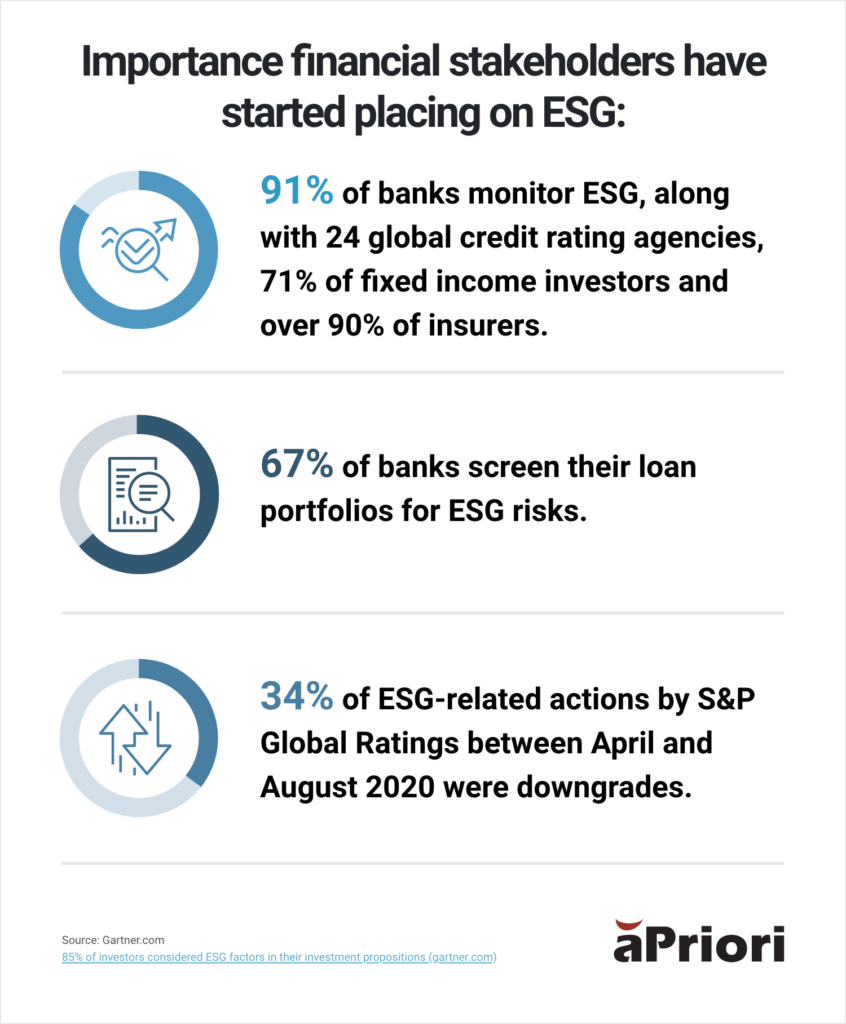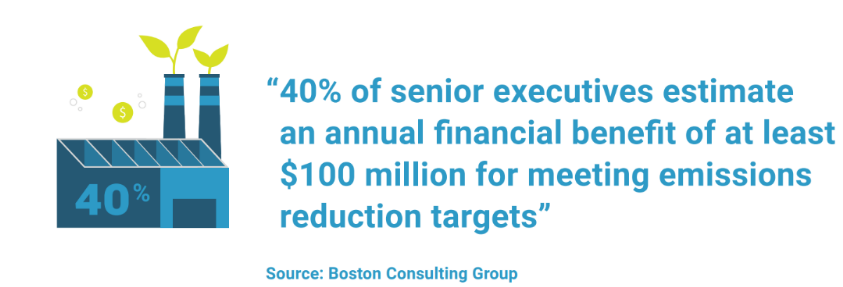Key Takeaways:
- aPriori’s Design for Sustainability can help manufacturers address sustainability challenges
- Learn about several challenges and how aPriori customers have successfully built sustainability mission statements and business models
The Full Article:
Ninety percent of executives believe sustainability is important, but just 60% of organizations have sustainability goals.
Creating and incorporating sustainability goals is essential to mitigate climate change and meet evolving investor pressure, consumer and manufacturing customer demands, and regulatory requirements.
What’s more, there’s a domino effect. If a company’s suppliers aren’t green, then technically, the company can’t be green either. As a result, some companies like GM have asked their suppliers to sign a pledge to advance global climate action and human rights.
It can be an effective strategy to bolster sustainability credentials. However, the sticking point is that not all suppliers can or are willing to make such a commitment. Harvard Business Review found that this quagmire persists globally. In many cases, low-tier suppliers in various countries lacked environmental management systems and/or socio-economic (e.g., human rights and workplace safety) policies.
Current Challenges to the Concept of Sustainability
When it comes to global warming and sustainability issues, many businesses must crawl before they walk. In other words, sustainability will be a work in progress with many moving parts. There is the implementation itself. Regulatory requirements are evolving, necessitating a solid grasp of what manufacturers must consider. Then there is ensuring that your product lifecycle, from design to suppliers and production, is green to meet the sustainability credential. Finally, the cost is, and always will be, a major consideration.
It is, therefore, not surprising that manufacturers face several sustainability challenges:
- Increasing pressure to show corporate sustainability stewardship and initiatives. Gartner found that 85% of investors considered environmental, social, and governance (ESG) factors in their investments in 2020. 91% of banks monitor the ESG performance of investments. It puts a tremendous burden on manufacturers.
- Strengthening partnerships with suppliers who support sustainability measures. Equally important ensuring those suppliers have proven and documented environmental data. It can be particularly challenging when working with multiple suppliers globally since sustainability and workplace regulations can vary greatly. In some cases, they are non-existent.
- Making the move to reshoring or at least reducing carbon footprint by utilizing suppliers and factories within a manufacturer’s geographical region. As a result of pandemic supply chain issues, the Ukraine war, and higher fuel costs, manufacturers are reconsidering the idea of reshoring. For many, the implementation costs can be off-putting.
- Communicating and collaborating more efficiently, improving traceability and analytics. Despite the available technology, there still are far too many manufacturing operations that are siloed. Sustainability initiatives require an all-hands-on-deck approach if they are to be successful. Communication and collaboration are essential to ensure full and transparent sustainability across the product lifecycle. Siloed teams will stymie this effort.
- Reducing waste without forgoing profit. Many manufacturers think achieving both sustainability and profitability is a conundrum. You can implement sustainability initiatives but at what cost? And if you try to cut sustainability corners, at what cost will it come?
Let’s explore how manufacturers can address these challenges. The good news is that it isn’t as daunting as it seems.
How aPriori Provides Solutions for Sustainability
As you’ll see below, aPriori is helping manufacturers make an impactful move to sustainability. First, discover how aPriori’s manufacturing insights can address sustainability challenges and ensure that benchmarks are achieved while enhancing manufacturability and cost objectives.
- Gain greater transparency through manufacturing insights and analytics. Eighty percent of a product’s early design determines its environmental impact. It underscores how imperative it is to have early feedback on design flaws, cost outliers, and potential carbon footprint impact. aPriori provides fast, automated geometry-driven analysis for 3D CAD data to evaluate the carbon footprint, reducing late-stage redesigns and identifying opportunities to lower CO2 emissions early on in the product development cycle. These insights and analytics can be used to track and quantify sustainability initiatives with stakeholders and investors as well.
- Improve relations and access to more suppliers, including those closer to your production facilities. Our platform encourages communication and collaboration across all channels of the product lifecycle, including with suppliers. As a result, waste is reduced, and time to market is accelerated. Due to enhanced supplier relations, manufacturers can identify and work more closely with those suppliers that are committed to and can certify sustainability within their organizations. This effort can pave the way for heightened sustainability metrics and certifications. The cherry on top? Better collaboration and communication facilitate more mutually beneficial supplier negotiations as well.
- Utilize our Regional Data Libraries (RDLs). aPriori provides Regional Data Libraries (RDLs)to confirm and enhance your sustainability commitment. Identify suppliers closer to home to help reduce your carbon footprint. Compare suppliers’ environmental impact based on their geographic location due to the local electricity mix. Reduce raw material waste by selecting the most appropriate process and comparing materials’ greenhouse gas emissions (GHG) as a result.
- Cloud collaboration across the product lifecycle with real-time, accurate data. Product design shape, as well as material and manufacturing process trade-off analyses for CO₂ footprint, can be conducted through digital factories, with full visibility into cost and manufacturability. This allows for more informed decisions to reduce environmental impact. Customers’ product needs and desire for more sustainable products are met by providing a CO₂e footprint breakdown to analyze and implement sustainability actions.
- Sustainability may cost more upfront but will save in carbon footprint expenses and fines in the long run. On the flip side, studies are finding that consumers are willing to pay more for sustainable products. So, these initiatives could result in greater profitability for manufacturers. Design for sustainability allows manufacturers to see where the carbon footprint can be reduced via manufacturability insights and cost outliers. They can evaluate CO₂ alongside cost to improve sustainability performance without sacrificing profitability, further enhancing decision-making and supporting sustainable development goals.

Sustainability Challenges Examples
Despite these manufacturers’ commitments to sustainability and the benchmarks they’ve achieved, they are not resting on their laurels. As a further indication of their sustainability commitment and desire to have a deeper impact, they utilize manufacturing insights tools to make further improvements to sustainable practices in their fields. Not only have they achieved great results for their organizations but for the environment and community at large.
Grundfos, a water technology company, manufactures products and creates solutions to reduce climate impact and help customers preserve our natural resources. As a socially responsible company, it is committed to sustainability and has built a business practice around it. Grundfos has achieved tremendous energy and water savings. It has improved its circulator pump technology for greater efficiency, saving 11.4 million MWh in energy consumption. Additionally, Grundfos has reduced CO2 logistic emissions by 10% since 2019. Its pump solution products helped the company’s end users reuse more than 1.8 billion m³ water per year. Finally, through sustainable innovations and smart water use and reuse solutions, the company has been able to become a circular economy. It provided basic water access to 1.6 million people in 2021.
- Signify, a company that provides commercial and retail lighting products, systems, and services. Signify, in the top 1% in its industry in the S&P Global Corporate Sustainability Assessment, also practices what it preaches through its environmental sustainability initiatives and successes. Since September 2020, Signify has been 100% carbon neutral and has contributed zero waste to landfills since that time. The lighting manufacturer’s products, systems, and services support food availability, security, and safety, as well as facilitate the health and well-being of those in need. Its sustainability commitment has paid big dividends to the bottom line, with 25-27% of its revenues coming from lighting innovations to help others. Signify also boasts 21-25% of its revenues from circular products, services, and/or systems, proving that sustainability and profitability can go hand-in-hand with the right manufacturing insights. At our recent Manufacturing Insights Conference, Luc Brassard, Head of Procurement at Signify, said, “Looking at challenges heading into 2023, materials, electricity, and gas prices are all increasing. The transparency provided by aPriori’s manufacturing data will help keep our costs under control and contribute to a more sustainable world. This is the future of procurement.”
Face Sustainability Challenges Head-On for a More Sustainable Business
Renewable energy sources and sustainability for future generations can be achievable, successful, profitable, and quantifiable. To tackle the environmental issues associated with manufacturing, it just takes the right strategy and the right manufacturing insights tools.
As in any organization, the key is finding the sweet spot in reaching goals. For manufacturers, it is balancing manufacturability, sustainability, and profitability. Sometimes, all three can be achieved simultaneously. Other times, a trade-off may be required in favor of reducing carbon emissions or, conversely, temporarily prioritizing costs over sustainability.
In the long run, it will improve manufacturability, meet sustainability goals, and increase energy efficiency, as well as engender trust and financing from stakeholders and investors. More importantly, you will help reduce your carbon footprint…for the most enduring and profound legacy.
Read Our Whitepaper to Meet Net Zero Product Manufacturing Goals
Discover how aPriori help uncover “hidden” CO2e during the critical product design stage.








